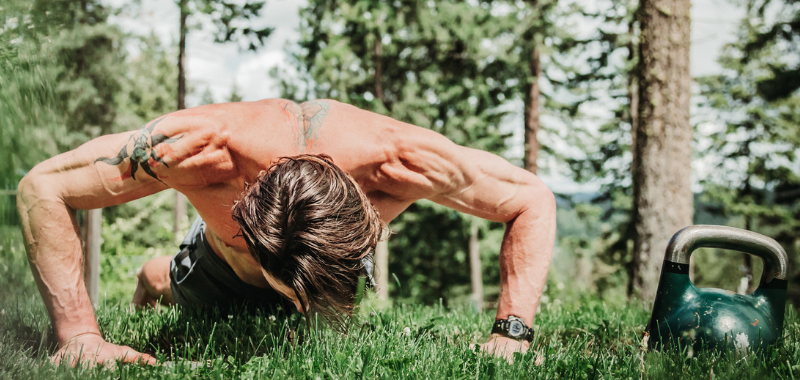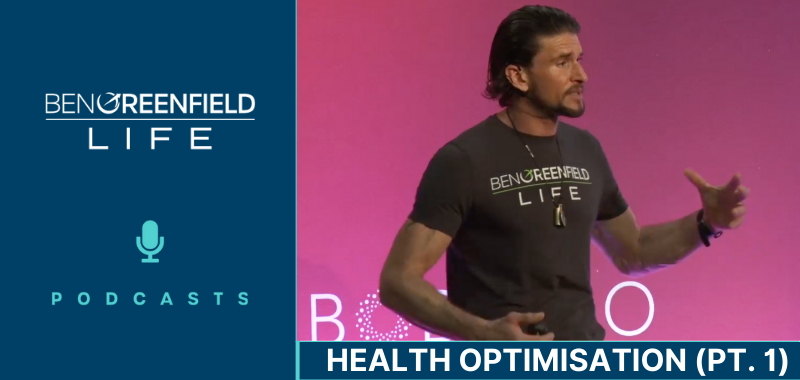March 16, 2021
From ancient Hindu steel maces to twisted variants of Olympic-style weightlifting bars like the X3 bar I discuss in this article to the crazy biohacked Vasper system I cover in this podcast, strength and conditioning equipment can vary from the simplistic to the wildly complex. These days, you have access to countless options for improving your strength, power, mobility and endurance, but despite modern society's latest innovations and conveniences, some of the oldest, most basic, tried-and-true pieces of equipment still reign supreme for one very good reason: they get the job done, even if they're not as sexy or expensive as all those other options out there.
One such piece of equipment – a staple in my own arsenal – is the kettlebell.
If you follow me on social media, particularly on Facebook and Instagram, you've likely noticed just how integral kettlebells have been in my training routine lately, most notably since the COVID pandemic struck and I shifted from hitting the gym to strolling out to my garage. Starting last year, as a way to both motivate and educate myself more in the realm of strength and conditioning, I’ve even been pursuing a few rigorous, intensive kettlebell certifications, specifically because of the myriad of benefits these odd-looking cast-iron weights provide: particularly improved strength, power, and endurance, recovery and rehabilitation, massive calorie burning, functional movement training, and much more.
The first of the two certifications I completed recently is the Russian Kettlebell Challenge (RKC) and the second is the StrongFirst SFG Certification—both created by the crazy man most closely associated with kettlebells in the United States, and a personal friend of mine: Pavel Tsatsouline.
In this article, you’ll learn more about these certifications, how to get certified with kettlebells yourself, plus everything you need to know about kettlebells—including their history, the science behind why they’re one of the most effective tools you can keep in your strength and conditioning toolbox, how to properly use them, the key workouts I used to prepare for my kettlebell certifications, and much more.
A Brief History of Kettlebells
 The kettlebell is simple in design. The weight features a handle attached to a heavy round base, and…
The kettlebell is simple in design. The weight features a handle attached to a heavy round base, and…
Well, that's pretty much it. Kinda boring, huh? But the beauty of kettlebells truly lies in their simplicity.
Now, there have been a few minor innovations here and there, such as adjustable kettlebells like the one I highlight in this Weekly Roundup post, but generally, the design hasn't changed much over the years. Ranging in weight from 4 to 175 pounds, the kettlebell's unique handle puts its center of mass further out from your body, which can make it a bit tougher to handle and maneuver than a standard dumbbell—but is also the reason kettlebells can be so effective at improving your strength, balance, and explosiveness.
While Kettlebells have just made a resurgence in the U.S. over the last couple of decades, they have been favored by many strongmen, endurance athletes, and fitness enthusiasts all over the world for far longer than that. They’ve gone by different names, such as “ring-handled weights” and “stone padlocks,” but the concept has always been the same. Kettlebells and their predecessors (like the Greek halteres have been used for thousands of years by groups ranging from ancient Greek athletes to Chinese Shaolin monks. If you’re familiar at all with the Scottish Highland Games, you’ve likely seen the “weight for height” event, which features a weight attached to a handle, much like a kettlebell, thrown over a high bar.
The first records of Russian kettlebell training (and the modern kettlebell as we know it today) appear in Russian dictionaries from as far back as 1704 where the handled weights were first used as counterweights to measure dry goods on scales in the marketplace. People began throwing the weights around for fun in their free time, and farming festivals started incorporating them as a new type of strongman challenge. In 18th-century Germany, physical educator Friedrich Ludwig Jahn founded the Turners System of Gymnastics, which heavily featured kettlebells.
But in spite of their long-running popularity, kettlebells disappeared in America seemingly out of nowhere in the mid-20th century. Some historians believe that as Russia—where kettlebells were famously popular—became a looming political and military threat in the form of the U.S.S.R., Americans made a deliberate effort to stay away from anything associated with Soviet Russia, including kettlebells. Others think that their disappearance was influenced by the rise of bodybuilding in America. Bodybuilding workouts primarily feature isolation exercises like bicep curls, tricep extensions, and leg presses, as well as a few compound lifts like the deadlift, squat, and bench press.
The kettlebell—which is used for a wide range of exercises, including the farmer's carry, swing, shoulder carry, Turkish get-up, clean and jerk, front squat, Snatch, military press, suitcase deadlift, single-leg deadlift, lunge, and many more—wouldn’t have had much of a place in bodybuilding workouts, and are also more difficult to learn and more metabolically demanding than, say, a Nautilus exercise machine or pec deck at the gym, so this may have impacted their decline of use of lack of popularity. But whatever the reason, the fact is that kettlebells experienced a fall in use spanning several decades in the U.S.
The Resurgence of the Kettlebell
I get into the nitty-gritty details on the resurgence of the kettlebell in my (aptly named) article “The Resurgence Of The Kettlebell: How An Old-School Tool For Strongmen Became A Must-Have Piece Of Equipment For Athletes And The Average Person,” so I'll spare you the history lesson…
…but the gist is that this recent resurgence all comes back to Russian Spetsnaz (special forces) instructor Pavel Tsatsouline.
Pavel immigrated to the U.S. in 1998 and began teaching Spetsnaz training techniques to U.S. special forces groups, which included a workout program to teach average Americans how to use kettlebells. You can watch one of the videos he created, entitled “Enter the Kettlebell,” below.
While Pavel wasn’t the first proponent of kettlebells in the U.S., what made his approach unique and appealing was how entertaining it was. As you can see in the video above, he played on common Russian tropes with his military-esque, dungeon-style training rooms, his use of the word “comrade,” and his thick accent.
Pavel’s approach was highly successful, not just because of his marketing and tropes, but because kettlebell training is extremely effective. Kettlebells are exceptional tools when it comes to combining strength with conditioning and the functionality of movement. Pavel himself talks not about training “lifts,” but rather training “movements.” So when he launched his Russian Kettlebell Challenge (RKC), it hit the ground running (or should I say “swinging?”).
In addition to being extremely effective, one reason Kettlebells may be making a comeback could be that more people are shifting from “vanity training” to functional fitness training. Whether this is in opposition to aesthetic-driven, physique-focused bodybuilding, or in response to the increasingly sedentary lifestyle many folks live nowadays—functional, movement-based exercises that develop mobility and athleticism have become the preferred method of training for those who have learned that having six-pack abs doesn't mean much if your mobility is akin to your common 21st-century couch potato.
Functional training focuses on exercises that mimic movements present in day-to-day life, and kettlebells are perfect for this.
- Need to carry 75 lbs. of groceries in one trip (OK, nobody needs to do this, but we all attempt it anyway)? Do some farmer's carries with a couple of kettlebells.
- Want to develop explosive leg and hip power for those weekly pick-up soccer games, or even, as Pavel writes about in his fascinating books, even a marathon or Ironman triathlon? Kettlebell swings have got you covered.
- Got an upcoming hunting or backpacking trip? Kettlebell shoulder carries will prepare you for carrying all your gear.
- Want to develop your coordination, strength, and balance when moving heavy objects at awkward angles? Turkish get-ups and kettlebell clean and jerks will do the trick.
Kettlebells are so effective for these movements because they activate multiple muscle groups in functional muscle “chains.” In other words, they’re compound lifts, and almost like compound lifts on steroids due to their asymmetric nature compared to, say, a barbell. For example, swings target the posterior chain that runs from your hamstrings through your glutes, spinal erectors, trapezius muscles, and posterior deltoids—similar to a deadlift. Kettlebell get-ups train ankle, knee, and hip stability, as well as shoulder, oblique, and abdominal strength.
The unique design of a kettlebell (remember, their shape and weight distribution is unlike dumbbells, barbells or plate-loaded machines) can help athletes already accustomed to these other options force their bodies to adapt to a new form of physical and neurological strain. Dumbbells have linear weight distribution, which means the weight is in line with the handle, but in a kettlebell, the weight is in front of the handle, a subtle yet significant difference that makes even basic kettlebell movements a challenge for athletes ranging from amateurs to professionals. (The first time I hoisted one overhead, I tried to push it just like a dumbbell, felt as though my wrist was going to snap, and had a sore arm for the next few days.) The kettlebell is so effective at building power and strength that British former powerlifter Andy Bolton, the first person ever to deadlift 1,000 lbs. in an equipped powerlifting competition, has long been an advocate for incorporating it into strength programs.
Kettlebell workouts are designed for high-rep, fast-paced sets, a style of training that breaks down muscle microfibers and creates a chemical response in your body that stimulates muscle growth, and also burns fat. There are a host of other benefits to training with kettlebells, including:
- Warm-ups: Kettlebells are ideal for warm-ups because the most effective warm-ups are dynamic movements like high kicks, side shuffles, air squats, lunges, and other exercises that enhance blood flow into the desired muscles and activate neurological movement patterns. Light kettlebell swings, cleans and presses are perfect for properly warming up multiple muscle groups at once.
- Cardio: Forcing your body to transition weight between different muscle groups for extended periods significantly increases your heart rate, making kettlebell workouts a fun way to burn fat and improve your cardiovascular conditioning. Kettlebell swings and snatches are especially effective as cardio-enhancing movements when combined with aerobic activities like jogging, cycling or jumping rope.
- Calorie Burning: A 2010 study from the American Council of Exercise found that kettlebell workouts burn about 1,200 calories per hour, compared to a mere 400 calories per hour during dumbbell workouts.
- Recovery and Flexibility: Recovery is enhanced through light training through injury; similar to warming up, these workouts improve blood flow through affected areas and deliver critical nutrients faster, making kettlebells an effective way to rehab injuries. Kettlebell training also increases the flexibility of athletes in ways that affect their performance through underlying motions, like hip extensions, that are fundamental to a variety of sports. This flexibility is also important for avoiding injuries in the first place.
With all of the benefits that accompany kettlebell training, it should come as no surprise that I have heavily emphasized kettlebells in my workouts over the last couple of years, allowing me to get a so-called “minimum effective dose of exercise” with some very satisfactory results in a short period of time. So when it comes to training and exercise, kettlebells are indeed a handy, time-saving life-hack.
How To Get Your Kettlebell Certification
Being the overachiever that I am, if I was going to get serious about my kettlebell training, I wanted to learn from the best.
So, I rolled up my sleeves and got to work this past year training for and completing two kettlebell certifications designed by Pavel himself in order to master this potent, multi-faceted training method.
The first kettlebell certification I completed back in 2020 is the Russian Kettlebell Certification (RKC), administered through a company called DragonDoor. An intensive two-day challenge, the RKC tests you on the swing, get-up, clean, front squat, snatch, and military press; auxiliary drills, cues, progressions, and regressions; and additional exercises including the suitcase deadlift, single-leg deadlift, kettlebell carries, lunges, and active recovery movements.
The second certification, which I started training for back in April of 2021, is the StrongFirst certification, also created by Pavel. StrongFirst offers two kettlebell certifications, the SFG I Kettlebell Certification and SFG II Kettlebell Certification. The certification I completed back in January in San Diego was the SFG I, which tests proficiency in the kettlebell swing, get-up, clean, press, snatch, and squat.
If you'd like to try your hand at completing any of the above certifications, below you'll find the exact workout I did to prepare for my SFG I certification, and I'd also like to give a shout out to my friend Joe DiStefano, a guest in these previous podcasts Kettlebell Yoga, The Best 5 Cardio Machines You Can Use, How To “Reset” Your Body With An Adventure & Much More! and Digital Detoxing, Travel-Proofing Your Immune System, Underground Body Weight Workouts & More With Joe DiStefano, for educating me quite a bit on properly structured kettlebell workouts and kettlebell programming.
But first, if you've never actually used a kettlebell before, here's a very brief primer on how to safely do so. Because they handle much more differently than a dumbbell you may be used to, you can easily hurt your wrist, shoulder, or lower back if you don’t use a kettlebell properly.
- First, for nearly every kettlebell exercise you do, you should keep your feet planted and your weight on your heels. This will ensure that your body is forming a strong foundation to lift and move the kettlebell.
- Next, you should never lift a kettlebell directly over your head. Compared to a dumbbell or barbell, it is much easier for your grip to slip or for you to drop the weight—and the last thing you want is a 35lb cast iron cannonball falling on top of your noggin'.
- Finally, just as you do with any exercise, you need to protect your lower back. Whether you’re picking the kettlebell off the ground, or swinging it up in the air, you should never slouch your lower back. Instead, the power and force for all movements should be generated by your hips and legs.
Before you get into some of the more complex exercises, start with the most basic and popular: the kettlebell swing. To perform this motion…
- Spread your feet shoulder-width apart and lean forward while holding on to the kettlebell with two hands and allowing it to hang down between your legs.
- Keeping your feet planted, push off the ground and allow the momentum from your legs to begin to swing the kettlebell up in an arc as you keep your arms straight.
- Thrust your hips forward as you continue to swing the kettlebell up to the level of your head, and then simply reverse the motion to be back in the ready position for the next repetition.
For a detailed breakdown of what a swing should look like, check out this video by Mike Salemi, also a previous podcast guest of mine on the episode “Training Secrets From The Freak Of Nature Who Can Hoist 51 Reps Of Double 72 Pound Kettlebells In 10 Minutes.“:
Training For Your Kettlebell Certification
Now, if you want to try a few of the same training strategies I personally used (inspired by Pavel and his books), below are a few of the key workouts I performed on a weekly basis to prepare for my kettlebell certification, performing each of the workouts below for about twelve consecutive weeks, which was highly repetitive, but allowed me to really “grease the groove” in terms of building muscular and neural pathways for kettlebell training strength and efficiency.
Mondays & Thursdays
Simple and Sinister Routine, 35 to 45 minutes (based on Pavel Tsatsouline’s book Kettlebell Simple & Sinister)
- Warm-Up: 4 minutes on the Airdyne stationary bike, jogging, or burpees
- Stretch: 1 to 2 rounds of the following (follow each set with 1 minute of nasal breathing on the Airdyne):
- 5 get-ups per side
- 10 reps prying goblet squats
- 10 reps deadlift
- 10 pull-ups
- Warm-Up Finisher: On Airdyne, 3-5, 10-30-seconds max efforts with long rest periods OR 1 single 30-second max effort.
- Main Set:
- 10 sets of 10 one-arm swings (5 sets for right arm, 5 sets for left arm) OR 10 sets of 10 double-arm swings
- Active “bouncing” recovery or easy Airdyne or treadmill walking between each set for 20-40 seconds, OR front plank hold
- Post-Main Set: 5 heavy get-ups per side.
Tuesdays & Fridays
Quick and Dead Routine, 35 to 45 minutes (based on Pavel's book The Quick And The Dead)
- Warm-Up: 4 minutes on the Airdyne, jogging, or burpees
- Stretch: 1 to 2 rounds of the following (follow each set with 1 minute of nasal breathing on the Airdyne):
- 10 pistol squats per side
- 10 Romanian deadlifts
- 5 bottoms-up presses per side
- 10 horizontal pull-ups
- 10 kettlebell overhead walking lunges per side
- Warm-Up Finisher: On Airdyne: 3-5, 10-30-seconds max efforts with long rest periods OR 1 single 30-second max effort.
- Main Set:
- 4 sets of 5 reps, or 2 sets of 10 reps per series. Total of 5 series per exercise, or 10 rounds total. Exercises are:
- Double-arm swings OR single-arm snatches
- Hardstyle or banded push-ups
- (Example of main set: 5 series of 4×5 swings or snatches to 4×5 push-ups OR 5 series of 2×10 swings or snatches to 2×10 push-ups. Timing is 5 reps every 30 seconds or 10 reps every minute. After the final set in a series, take a full minute of active, bouncing rest before the next series begins. For example, do a set of 10 swings two times, starting each new set on the minute, then rest a minute; repeat with push-ups; continue until you’ve performed 10 sets for each exercise).
- 4 sets of 5 reps, or 2 sets of 10 reps per series. Total of 5 series per exercise, or 10 rounds total. Exercises are:
- Post-Main Set: 5 heavy get-ups per side
Saturdays or Sundays
- Warm-Up: 4 minutes on Airdyne, jogging, or burpees
- Main Set: Follow each set with 1-2 minutes of easy walking or stationary bike while nasal breathing.
- Death by carries – Carry two kettlebells overhead as far as possible, then switch to racked position (kettlebells on shoulders, elbows tucked into body) as far as possible, then farmer’s carry position as far as possible
- Double kettlebell clean – 10 reps
- Double kettlebell front squat – 10 reps
- Post-Main Set: 5 minutes 24 kg. snatch test. Complete 100 reps, 50 per side, alternating 5-10 reps/side. Break up into multiple sets if necessary to maintain good form.
Other Movements/Exercises/Workouts I Performed
- Every Day
- 10-15 minutes foam rolling and mobility exercises
- 30-60 minutes of easy walking
- 4 Days Per Week
- 30 minutes in the sauna with breathwork and yoga flow, followed by a 3-5 minute cold plunge
- 2-3 Days Per Week
- 21 minutes of cardio/HIIT interval training on VASPER machine
Summary
When asked if kettlebell training is a fad that came and will eventually go, Pavel once said that they are, and he predicts that the fad will die out in a few hundred years. But whether or not they’re a fad, kettlebells, as we know them, have already been around since at least the 1700s, and there’s no question as to why.
Everyone, from weekend warriors to elite athletes, can benefit from kettlebell training. Whether your goal is to rehab an injury, augment a barbell training program, improve cardiovascular conditioning for a race, enhance your functional movement training, or just be able to make it from your car to your house with all of your groceries in one trip—working out with kettlebells can get you there.
If you're interested in beginning training with kettlebells and want to become an expert yourself, I highly recommend Kettlebell Kings kettlebells (save 15% with code GREENFIELD), either the Russian Kettlebell Certification (RKC) or the StrongFirst certification (or both, if you want to experience a couple different “flavors” of kettlebell training), and Pavel's books Kettlebell Simple & Sinister and The Quick And The Dead.
Additionally, here are a few podcasts and articles of mine on Kettlebells:
- The Resurgence Of The Kettlebell: How An Old-School Tool For Strongmen Became A Must-Have Piece Of Equipment For Athletes And The Average Person.
- How To Use Kettlebells: Get Training Tips And Sample Workouts For Kettlebells
- How To Biohack Fat Loss With A Kettlebell
- One Potent Tool And Three Simple Exercises To Gain Massive Endurance In Minimum Time.
- Training Secrets From The Freak Of Nature Who Can Hoist 51 Reps Of Double 72 Pound Kettlebells In 10 Minutes.
How about you? Do you train with kettlebells, or have a kettlebell certification? What are some of your favorite kettlebell exercises? Let me know in the comments section below, along with any thoughts, questions, or feedback you have!














Hi, you shared a wonderful post about kettlebell training. I went through it last week and I am following your weekly plan.
Cool! Thank you for sharing the information, I don’t have kettlebells at home, but I do have dumbbells and I just adore them, before I didn’t work with weights at all, but then I realized that I no longer had enough weight in my own body and bought dumbbells. This is a very cool thing! Sports activities with them are much cooler and more effective. Do you think kettlebells and gatrels are very different? Or is a kettlebell still more effective for squats?
Great article! I really liked that there is a recommendation plan for work for each day.
Love kettlebells. Love Pavel and strong first. Wow, 12 weeks with that volume. I’m 46 and my body is feeling good 2-3 days a week. I don’t race the clock and use the maffetone method when I swing, snatch, TGU………
All the other stuff you’ve added. Good on you for being able to handle the load.
For more visit cbdsstore.com
How can an exercise modality that involves expensive certifications and courses be called dirt cheap ?
Farmer’s Walk should be a “body weight exercise”, i.e. half your body weight in each hand. Gets a bit spendy with kettlebells.
Love kettlebells. Love Pavel and strong first. Wow 12 weeks with that volume. I’m 46 and my body is feeling good with 2-3 days a week. I don’t race the clock and use the maffetone method when I swing, snatch, TGU………
All the other stuff you’ve added. Good on you for being able to handle the load.
would love recommendations of great online kettlebell workout programs (videos) — it”s so much easier to be inspired when you are following along.
Check Caroline Girvan on Youtube, she just upload 5 days kettlebell program
Good write-up, but not a word about the “real deal” – Girevoy Sport. Also, which style KTs do you use? Competition or hard/crossfit style? Any preference? You have both styles in your photos, but those do make a huge difference in technique. Thanks!
Hope the shoulders hold up.
I’m sure his shoulders will be alright being that most of the force is generated from the hips and I’m sure he is utilizing the proper form.